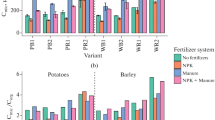Abstract
The effects from the multiyear use of grain–fallow–plow crop rotation schemes comprising legumes, permanent cultivation of winter rye and barley, and bare fallow regime on the ecological and physiological state of microbial communities in a sod-podzolic heavy loamy soil were examined in the course of a long-term, stationary experiment. Biological activity parameters of soil microbiocoenoses, including the potential intensity of CO2 emission, microbial biomass gross respiration rate, metabolic coefficient, and nitrogen fixation, were assessed. It is shown that the application of organic fertilizers (manure) in the crop rotation scheme with 28.6% legumes ensures the best humus state of the soil and a significant increase in the total nitrogen content. It is established that the share of microbial biomass (Cmic) in the total organic matter of the sod-podzolic heavy loamy soil is 1.50–3.24%. The application of mineral fertilizers results in a slight decrease in the microbial biomass carbon content and increase in the labile organic carbon content. The metabolic activity of microbial communities decreases in all long-term experimental scenarios regardless of the land use techniques. The permanent intensive cultivation of crops, either with or without crop rotation, disturbs the microbiocoenosis stability in soils of the Cis-Ural region.
Similar content being viewed by others
REFERENCES
Ovchinnikova, M.F., Gomonova, N.F., and Mineev, G.V., Content, composition, and mobility of humic substances of sod-podzolic soil and the level of its bioproductivity under long-term application of agrochemical agents, Dokl. Ross. S-kh. Akad., 2003, no. 5, pp. 22–25.
Drozdov, I.A., Tyulin, V.A., and Sutyagin, V.P., Mineral and organic fertilizers of adaptive crop rotations of the Upper Volga, Usp. Sovrem. Estestvozn., 2017, no. 12, pp. 45–49.
Ovchinnikova, M.F., Gomonova, N.F., and Mineev, V.G., The specificity of the composition and properties of humic substances in sod-podzolic soils of different degrees of cultivation, Dokl. Ross. S-kh. Akad., 2006, no. 8, pp. 27–31.
Gomonova, N.F. and Mineev, V.G., Dynamics of the humus state and the nitrogen regime of sod-podzolic medium loamy soil with long-term use of fertilizers, Agrokhimiya, 2012, no. 6, pp. 23–31.
Rusakova, I.V., The influence of straw of grain and leguminous crops on carbon content, agrochemical properties, and the balance of nutrients in sod-podzolic soil, Agrokhim. Vestn., 2015, no. 6, pp. 6–10.
Zolkina, E.I., The influence of long-term use of fertilizer systems on the balance of nutrients in grain cultivating crop rotation, Agrokhim. Vestn., 2017, no. 6, pp. 67–70.
Nikitishen, V.I. and Lichko, V.I., Nitrogen budget in agroecosystems on gray forest soils under long-term fertilization, Eurasian Soil Sci., 2008, vol. 41, no. 4, pp. 429–440.
Dubenok, N.N., Borodychev, V.V., Lytov, M.N., and Pakhomov, D.A., Formation of a deficient nitrogen balance in the soil in the cultivation of legumes, Agrokhim. Vestn., 2007, no. 5, pp. 9–11.
Postnikov, P.A., Crop rotation productivity when using biologization techniques, Agrarn. Vestn. Urala, 2015, no. 6, pp. 20–23.
Gorobtsova, O.N., Uligova, T.S., Tembotov, R.Kh., and Khakunova, E.M., Assessment of biological activity in agrogenic and natural chernozems of Kabardino-Balkaria, Eurasian Soil Sci., 2017, vol. 50, no. 5, pp. 589–596.
Zavarzin, G.A. and Kudeyarov, V.N., Soil as the key source of carbonic acid and reservoir of organic carbon on the territory of Russia, Herald Russ. Acad. Sci., 2006, vol. 76, no. 1, pp. 12–26.
Kudeyarov, V.N. and Kurganova, I.N., The breath of the soil of Russia. Analysis of the perennial monitoring database. Overall assessment, Pochvovedenie, 2005, no. 9, pp. 1112–1121.
Agrokhimicheskie metody issledovaniya pochv (Agrochemical Methods of Soil Research), Moscow: Nauka, 1975.
Shkonde, E.I. and Koroleva, I.E., On the nature and mobility of soil nitrogen, Agrokhimiya, 1964, no. 10, pp. 17–35.
Ananyeva, N.D., Susyan, E.A., and Gavrilenko, E.G., Determination of the soil microbial biomass carbon using the method of substrate-induced respiration, Eurasian Soil Sci., 2011, vol. 44, p. 1215.
Emer, N.R., Semenov, A.M., Zelenev, V.V., Zinyakova, N.B., Kostina, N.V., and Golichenkov, M.V., Daily dynamics of the number and activity of nitrogen-fixing bacteria in fallow and intensely cultivated soils, Eurasian Soil Sci., 2014, vol. 47, no. 8, pp. 801–808.
Zav’yalova, N.E., Kosolapova, A.I., and Storozheva, A.N., The effect of increasing doses of full mineral fertilizer on organic matter and nitrogen regime of sod-podzolic soil of the Cis-Ural region, Agrokhimiya, 2014, no. 6, pp. 20–28.
Funding
This work was supported by the Russian Foundation for Basic Research, project no. 17-45-590166 r_a.
Author information
Authors and Affiliations
Corresponding authors
Ethics declarations
The authors declare that they have no conflict of interest. This article does not contain any studies involving animals or human participants performed by any of the authors.
Additional information
Translated by L. Emeliyanov
About this article
Cite this article
Kovalevskaya, N.P., Zavyalova, N.E., Sharavin, D.Y. et al. Biological Activity of Sod-Podzolic Soils in a Long-Term Experiment Involving Various Agrotechnical Methods. Russ. Agricult. Sci. 45, 364–368 (2019). https://doi.org/10.3103/S1068367419040086
Received:
Revised:
Accepted:
Published:
Issue Date:
DOI: https://doi.org/10.3103/S1068367419040086




